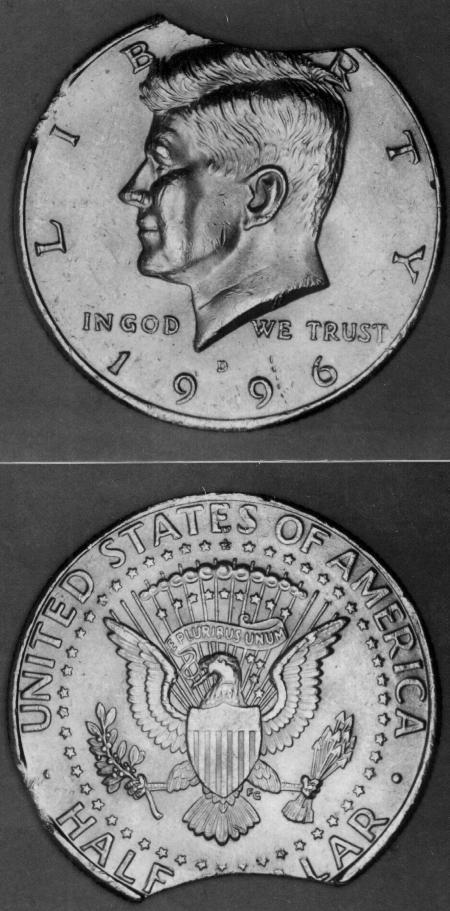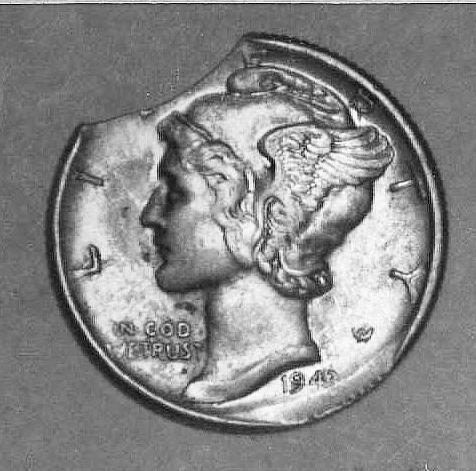
Ken Potter's Educational Series ...


Ken Potter's Educational Series ...


The the term "Curved Clip" is actually a popular misnomer that error collectors tend to accept in describing a general class of planchet error that originates with a blank that was produced with an incomplete area of metal at its edge. The error occurs when a blank is punched from out of an area of strip that overlaps a hole (or holes) from where a blank was previously punched out. Envision using a cookie cutter to "punch" out a cookie from an area of rolled out dough that overlaps into an area from where you already cut out a cookie and it’s easy to understand how the "curved clip" errors occurs.

Many curved clips are faked by punching the curved clip out with a common punch found in almost any die shop or through other cruder methods while "straight clips" (which will be the subject of another article) are faked by filing metal away from the edge. Collectors should take time to learn the diagnostics of this class of error even more than some of the other error types due to the ease and frequency in which they are faked.
No matter what class of clip is involved, in many cases, the rim opposite the clip will be flat and poorly formed. This effect is known within the hobby as the "Blakesley effect" and occurs due to the absence of pressure in that area during the upset (or rimming) process.
Normally the blank rotates through the mill which becomes increasingly tighter on the opposing sides of the blank as it progresses through. This creates the pressure necessary to upset the rim. When the blank rotates to the area of the clip the pressure is released and the rim fails to be formed in the area opposite the clip.
However, the "Blakesley effect" does not always appear on the struck coin; most probably due to a heavy strike, and collectors must learn to recognize other diagnostics of a genuine clip. Look for tapering at the edge (especially at the extreme opposite edges or lips of the clip where it meets the raised rim) and notice how the metal flows and design details close to the edge stretch or elongate. Not all of these effects always occur and sometimes they are minimal but one or more of these diagnostics will generally be present on a genuine clip.
Our first coin is a nice BU 1976-D Bicentennial quarter with a very large curved clip at about 8:30 accompanied by two smaller but noteworthy clips at 11 o'clock and 5:30. It is so well struck that a "Blakesley Effect," is not present. It is easily authenticated by the metal flow and resulting irregularity most obvious on the largest clip. This can not be duplicated with the typical round punch found in many machine shops. Curved clips this nice on Bicentennial quarters are rare and seldom encountered today!

Our next coin (above) is a 1996-D Kennedy half dollar with double
curved clips. This is a nice BU example with a large curved clip at about 1:00
o'clock accompanied by a smaller curved clip at about 10:00 o'clock. The
"Blakesley Effect," is light but clearly present opposite both clips and
authenticates them as genuine. Another indicator of the coin's authenticity is
evidenced by the metal-flow-lines on the stars next to the larger clip. They almost
appear as if they are moving in the direction of the clip. The "flow" is
caused by the absence of metal in that area of the blank and zero contact with the collar
to restrain metal flow. As a result the designs in the proximity of the clip are not
fully formed as metal flowed outward toward the rim rather fully into the design cavities
of the die.

Coin courtesy of Bill Ewald
Our final coin is a large single curved clip on a 1943 Mercury dime. This one shows very strong evidence of the "Blakesley Effect" opposite the clip.
Owning a few genuine clips and studying them with a
good magnifying glass is by far the best method of learning what to look for as many of
the diagnostics described in this article can’t be readily seen without higher
magnification. I recommend your first purchases be made from a dealer knowledgeable in the
area of errors so that you get a good start. Good luck finding some good ‘uns!
They are out there!



Numismatist Since 1959 ~ Serving
the Collector Since 1973
CONECA's Longest Serving Doubled Die Attributer
Member of: ANA CONECA-LM NLG NCADD-FM
MSNS-LM
NWDCC RCC COINMASTERS LCS WBCC BBCC

Free counters provided by Andale.